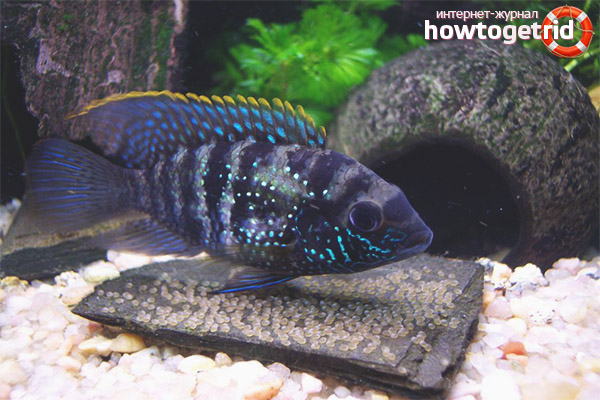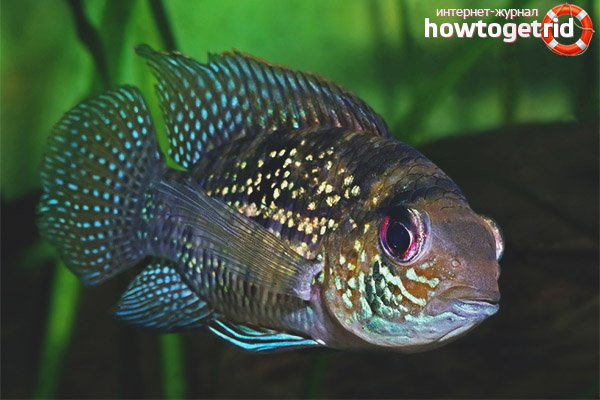The content of the article
Bluish-spotted acars have long been considered one of the most common cichlids among aquarium fish lovers in South America. Their name is translated from Latin as "beautiful." This breed is easily confused with another similar species - turquoise Akars. However, they are quite different from each other. Turquoise acars are larger and grow under natural conditions about 30 cm, while bluish-spotted ones have a maximum length of 20 cm. Sexually mature turquoise males have a pronounced hump in the head area, consisting of adipose tissue, bluish in males - spotted cancer it is less pronounced.
Bluish-spotted acars are great for keeping in an aquarium owners who prefer cichlids. They do not require complicated care. It is only important to maintain the temperature and quality nutrition. They perfectly care for their offspring, without creating additional problems for aquarists.
They are more tenacious in comparison with other cichlids, for example, turquoise Akaras. Medium-sized and peaceful fish can be kept in aquariums with the rest of the species and other large aquarium fish.
Fish of this breed perfectly exist in the same aquarium with their relatives, creating pairs between themselves. Most often, they are not inclined to pay special attention to other residents if they observe territorial boundaries. Conflicts can occur during spawning, which in bluish-spotted cancers occurs on average once every 14 days if you remove the eggs. Given that they breed quite often, it is simply necessary to do this.
Origin
Appearance
Bluish-spotted acars have an oval-shaped body that looks squat and fleshy. Anal and dorsal fins are pointed. Compared with other representatives of cichlids, they have an average size of about 20 cm in the natural environment. In an aquarium, they, as a rule, do not grow more than 15 cm. The lifespan of fish of this breed is up to 10 years. During puberty, their size is about 6 cm, and they begin to spawn when their body is about 10 cm in length.
The color of bluish-spotted cancers reflects the name of the representatives of this breed of fish. The body has a grayish-blue color and is decorated with black stripes arranged vertically. The scales are colored with bluish nacre.
Content Features

Unpretentious fish are great for beginner aquarists, unlike turquoise cancers. Since they do not reach such impressive sizes as other cichlids, they do not require such a large aquarium. They are unpretentious in nutrition and breed easily. The only important condition in the content is the purity and temperature of the water.
Food
Representatives of this fish breed are predators, so their diet should contain a fairly high amount of protein. Under natural conditions, they feed on worms, larvae, and invertebrates. At home, they are fed artemia, koretry, pipe makers and bloodworms.Their diet can include frozen food - cyclops, brine shrimp, artificial flakes or feed in tablet form. Feeding is carried out twice a day, with different feed options.
Aquarium Requirements
For two representatives of this species, aquariums larger than 150 liters are suitable. To equip the bottom, clean sand is used, preferably river, they like to rummage through it. In this case, any vegetation of large and hard species is planted in special pots. Mandatory is the presence in the aquarium of a place where the fish can hide.
It is desirable to lay out the bottom with dry leaves of oak or beech. Their presence allows you to maximize the existence of cancer in the house to natural conditions that are comfortable for them. In addition, leaves are needed as a food source for fry.
It is imperative that the aquarium has high-quality external filters that create water movement. It is necessary to siphon the bottom and change the water in order to maintain cleanliness in the place of residence of the cancers. In general, they are quite unpretentious and have good adaptive abilities. Ideal water temperature are marks from 22 to 26 degrees, the pH level is about 7.
How do they get along with the rest of the inhabitants?

Living with other representatives of the fish family is not problematic under the conditions that they have approximately the same dimensions. Bluish-spotted Akars are not aggressive, but are able to defend their territorial borders, especially when spawning. They should not be kept together with shrimp and other invertebrates, which can become easy prey for them.
The most suitable neighbors for bluish-spotted cancers are catfish: platidoras, sack-gill, anti-citrus. Among the fish: cichlomas, eight-lane and scalar.
Sex differences
Breeding rules
They are quite suitable for breeding in aquarium conditions. They usually lay eggs on flat and even surfaces of glass or stones. They reach puberty when their sizes are between 6 cm. They choose a pair for themselves. Often aquarists buy fry in the amount of several pieces, which then themselves form pairs between themselves.
For spawning, water with a pH of about 7 and a temperature regime with marks of about 25 degrees is suitable. After the female lays eggs, the male is involved in the protection of future offspring. They are considered good parents who very carefully raise their fry. Artemia nauplii and other large feeds are used to feed offspring.
Video: Akara bluish-spotted










Submit